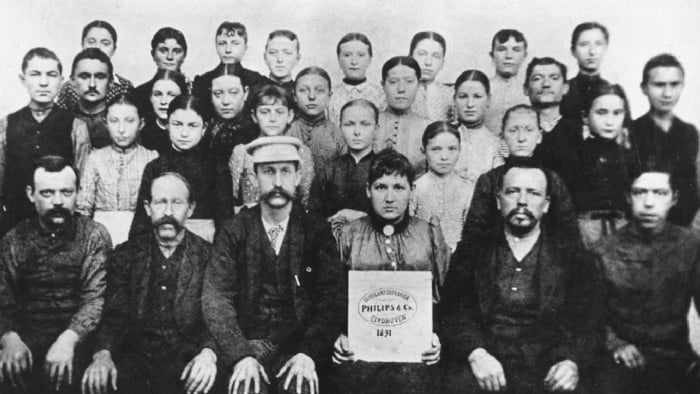When considering the evolution of technology and groundbreaking innovations, Philips emerges as a prime example of resilience and forward-thinking. With roots stretching back more than a century, Philips has been a pioneer in the electronics industry, profoundly shaping our interaction with technology. Let's delve into its fascinating journey from a modest Dutch enterprise to a global health technology leader. Uncover the advanced capabilities of the Philips 5500 LatteGo review
A Modest Start: Founding Philips
Philips was founded in 1891 by Gerard Philips and his father, Frederik Philips, in Eindhoven, Netherlands. The company's initial focus was on producing carbon-filament lamps, a humble beginning that laid the foundation for Philips’ future prominence. Despite early financial struggles and strong competition, their dedication to quality and relentless drive for improvement allowed Philips to survive and ultimately flourish. Get a closer look at the features of the Philips 5400 LatteGo review
Early Innovations and Growth
By the early 1900s, Philips had grown into one of Europe's largest producers of light bulbs. This success was not solely based on large-scale production but also a dedication to innovation. In 1914, Philips established the Philips Research Laboratory, commonly known as NatLab, marking a major milestone. This research center cultivated a culture of innovation that fueled future breakthroughs and laid the groundwork for the company’s expansion. Compare these two machines side by side in the Philips LatteGo 5400 vs 4300 review
Exploring Radio Technology
In the 1920s and 1930s, Philips diversified into radio technology, capitalizing on the burgeoning interest in radio broadcasting. In 1927, they launched their first radios, which quickly gained widespread popularity due to their quality and affordability. By 1932, Philips had sold over one million radios, demonstrating their strong understanding of market dynamics and consumer desires. Discover the differences among these models in the Philips 3200 vs 4300 vs 5400 review
Overcoming Adversity During World War II
World War II brought significant challenges to Philips. Operations were disrupted, and several facilities were damaged. Despite these challenges, Philips demonstrated incredible resilience. The company relocated key personnel and continued vital research, contributing to advancements in radar technology and other wartime innovations. This period underscored Philips' creativity and tenacity in the face of adversity. Learn how these two models compare in the Philips 3200 vs 4300 review

Post-War Innovations and the Cassette Tape
After the war, Philips entered a new era of expansion. The 1950s and 1960s saw the introduction of groundbreaking products, most notably the compact audio cassette in 1963. This innovation transformed the way people listened to and recorded music, becoming a global standard that shaped the music industry for years to come. See what sets these models apart in the Philips 3200 vs 5400 review
Transforming Music with the Compact Disc
Philips' commitment to collaboration led to a fruitful partnership with Sony in the late 1970s, culminating in the creation of the compact disc (CD). The CD redefined how music was experienced, providing a new, durable format for digital audio. This development not only revolutionized the music industry but also showcased Philips' dedication to pushing technological limits and building international partnerships to foster progress. Get a detailed review of the Philips LatteGo 5400 review
Diversification into Consumer Electronics and Televisions
In the latter part of the 20th century, Philips continued to expand, making substantial advancements in consumer electronics. They played a key role in developing the VHS format and later the DVD, reshaping home entertainment. In the 1990s, Philips introduced the innovative Ambilight TV, enhancing the viewing experience by surrounding the screen with ambient light that corresponded with on-screen content. Discover the compact and efficient design of the Philips 3200 LatteGo review
A Shift Toward Healthcare Technology
Recognizing emerging opportunities, Philips began investing in healthcare technology in the 1980s. Over the years, the company expanded into medical imaging, patient monitoring, and health informatics, ultimately positioning itself as a leader in health technology. Strategic acquisitions helped Philips build a robust healthcare portfolio, aiming to enhance patient outcomes and improve healthcare efficiency. Dive into the advanced features of the Philips 4300 LatteGo review
From Consumer Electronics to Health Technology
In recent years, Philips has undergone a major transformation, shifting its focus from traditional consumer electronics to health technology and lighting solutions. In 2016, the lighting division became a separate entity named Philips Lighting, which later rebranded as Signify. This allowed Royal Philips to focus fully on health technology, aligning itself with global trends toward health, wellness, and advanced medical solutions.
Sustainability and Corporate Responsibility
Philips has always shown a commitment to sustainability and corporate responsibility. The company has established ambitious targets, such as achieving carbon-neutral operations and embracing circular economy principles. These initiatives reflect Philips' dedication to fostering environmentally conscious practices and contributing positively to society.
Leveraging Digital Transformation
In today’s digital era, Philips has embraced artificial intelligence (AI) and data analytics to enhance its healthcare offerings. Their focus on connected care and smart health solutions illustrates Philips' vision of a future where technology significantly contributes to improved patient outcomes and well-being.

Conclusion: A Legacy of Vision and Resilience
Philips' rich history is a testament to its innovative spirit, resilience, and adaptability. From producing simple light bulbs in a small workshop to becoming a leader in health technology, Philips has continuously evolved with a commitment to enhancing lives through meaningful innovation. Their influence spans various industries—from changing the way we listen to music to driving the future of healthcare.
As Philips continues to innovate and push boundaries, their legacy stands as an enduring example of how consistent progress and a focus on societal well-being can transform industries and improve lives worldwide. The future for Philips promises to be as dynamic and impactful as its storied past.
